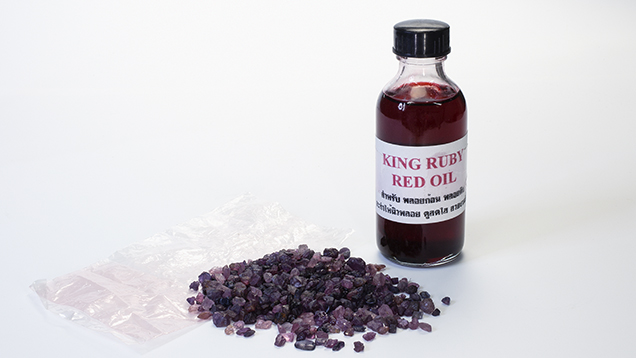When it comes to clarity enhancement with oils and resins, a common belief is that the refractive index of the host gem must match that of the filler. If one follows this logic, it would seem that using oils or resins to clarity enhance corundum (n = 1.76) or spinel (n = 1.72) would not be at all effective, since there is a yawning gap in RI between those gems and that of any oil or resin.
Certainly, Burmese gem traders have never bought into that idea, for we regularly encounter oiled rubies, sapphires, and spinels from Myanmar. In fact, Burmese traders have told us that it is common practice to immediately immerse rough into oil after it is unearthed (figure 1). Oiling rough not only makes viewing the interior easier but also significantly enhances the gem’s clarity. In our experience, such treatment is almost never disclosed to buyers.
In 2013, while visiting various mines and markets in Myanmar’s Mogok Stone Tract, we were taken to a small house where a man was heat-treating spinel. Gems were placed in a crucible and heated for a period of time. Then, while still relatively hot, they were dumped into a vessel containing red oil. It was a remarkable piece of performance art. After the oil was wiped off, we could discern no change in color from the heating.
Because of the prevalence of oiling, we now check every stone with fissures for oil, no matter the origin or type of gem. This is typically done with a hot point under the microscope. The hot point gently heats the gem until, with oiled stones, the oil leaks out of the fissure in beads on the surface of the stone. With the exception of emerald, customers purchasing colored gems are not expecting them to be clarity enhanced. As one major Bangkok trader told us several years ago, “I cannot sell an oiled spinel.” For this reason, when we determine that a gem other than emerald has been fissure-filled with an oil or resin, we notify the client and allow them two opportunities to remove the filler before we issue the report.

In September 2020, Lotus Gemology received for identification a 3 ct spinel that originated from Mogok. We noticed a fissure on the pavilion running parallel to the girdle plane, and application of the hot point caused oil to leak out. After two rounds of oil removal by the client, the difference was truly remarkable. The gem was now disfigured by a highly reflective eye-visible fissure (figure 2).
This clearly demonstrates that oil can have a significant impact on the clarity of a gem even when there is a big difference in RI between the host and the oil. The greatest impact will be found in stones like this spinel, where fissures lie perpendicular to the viewing angle.
Article Credit: GIA

